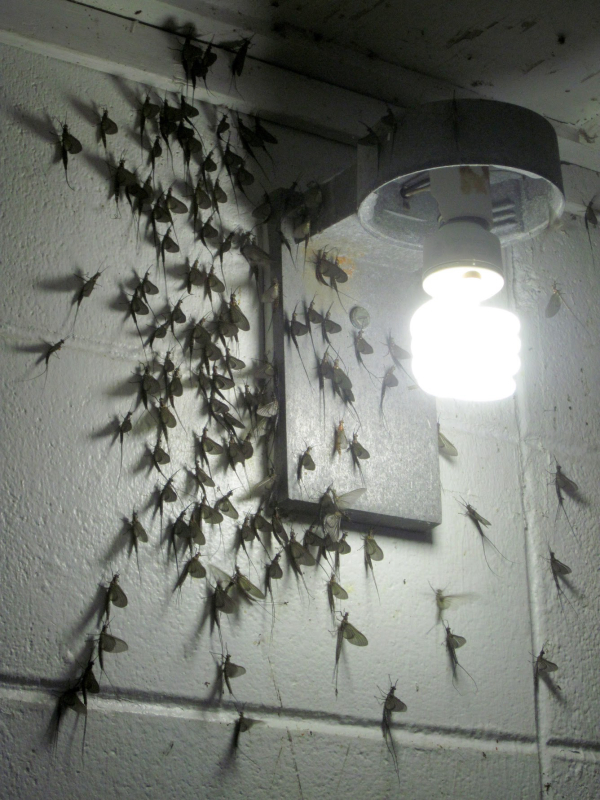
Topwater lures that make lots of noise work well when the Mayfly bite is on. (Yo-Zuri Lures)
I had Mayflies in my nose. Mayflies in my ears. Mayflies crawling inside my shirt. I didn’t dare open my mouth.
As I tried to boat the bass, the boat had drifted into a willow overhanging the water, and the limbs were so loaded with the insects that the color of the leaves was invisible.
Dozens of them fell into the boat, and dozens more swarmed over me. They crunched on deck under my feet
A squirrel fat as a toad hung from one of the limbs above me gulping down the bugs, while robins and grackles swarmed the bugs on the top of the tree.
And in the water below was fish soup.
Countless bluegills, sunfish, crappie and baby bass were swarming, picking off the hundreds of insects falling into the water or coming to the surface from below—the emergers.
And under the panfish was a school of hungry largemouth, eating the panfish.
About every fourth or fifth cast, a bass from 3 to 4 pounds would come roaring up from below to blast my topwater plug, a twin prop bluegill imitation. It was steady action, from about an hour before sundown until it got too dark to see.
That was this week on Guntersville, but the same kind of fishing is available anywhere there are Mayflies, as countless millions of these amazing little insects complete their life cycle with their single day of adult life.
While their purpose is continuing their species, they seem made to create great fishing where ever they’re found.
Finding Mayfly lakes and rivers is no challenge—just drive along the shores at dawn or dusk and check porch lights and street lights. If there’s a Mayfly hatch, the lights will have a diaphanous cloud of bugs whirling around it, and hundreds more sitting on any nearby structure.
The incredible hatches rising from the water are a panfish angler’s dream, of course. Any type of small popper or sponge spider assures a cooler full of bluegills and sunfish, and both crappies and white bass will also get in on the action.

Mayflies make themselves pretty obvious at dawn and dusk, and also swarm around outside lights after dark. (Frank Sargeant)
But if you want largemouths, switch to a bass-size popper or propeller plug and you’ll frequently find them hanging under the panfish, grabbing any that are bite-sized. Most are 2 to 4 pounds, but there may be an occasional 6-pounder in the mix on productive lakes like those in the TVA chain.
The best areas are where trees overhang the water. The Mayflies seem to particularly like willow trees, but any tree with lots of leaves draped a few feet above the water will draw them.
The action happens for about two hours after first light, and in the last two hours before dark. Just keep an eye on the surface and where you see lots of fish popping try a dozen casts or so—if the bass are there, they’ll let you know. Work the plugs slowly, with plenty of pauses of 5 to 10 seconds—strikes usually come as the lure sits still, and they can be explosive.
Lures that work well for this include the Berkley Spin Bomb, YoZuri 3DB Popper and Prism Shad, Rebel Pop-R and similars.
It’s an annual feast for anglers, and it’s at a peak right now across much of largemouth bass country. Just be sure to keep your mouth firmly closed.
Cicadas Too!

David Knapp of TroutZone Anglers specializes in tailwater floats during cicada season. (TroutZone)
Mayflies are not the only topwater feast going on at this time of year. In some areas, emerging cicadas are adding to the buggy feast for fish—like Mayflies, they sit on shoreside vegetation to dry their wings and many fall into the water to become fish food.
David Knapp and his Trout Zone team reports from the Smokies tailwater rivers that not only whopper brown and rainbow trout are rising to the big locust imitations but also carp that weigh up to 15 pounds, an unimaginable battle on a 5 or 6 weight flyrod. Best way to get on this bite is to book a float trip on the Caney Fork or one of the other tailwater streams in the area—info at https://troutzoneanglers.com.